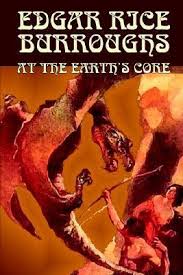Chapter XV — At the earths core
byChapter XV opens on a bleak and boundless plain, where David Innes and Dian emerge into a world both foreign and unforgiving. Without familiar landmarks, the vastness feels disorienting, but also symbolic—a reminder of how much still lies unknown in Pellucidar. The presence of lidis, enormous four-footed beasts used as mounts by distant tribes, introduces new allies and threats all at once. These nomadic riders, initially wary, offer insights into the scale and diversity of civilizations buried beneath Earth’s crust. Innes quickly learns that unity will be their only defense against the ruling Sagoths and the intelligent yet cold-blooded Mahars. Every alliance formed becomes a step toward liberation, though tensions always simmer. Trust remains a scarce and fragile currency in this underground world.
As plans take shape, the idea of coalition warfare feels both revolutionary and necessary. Innes is no longer just a visitor—he’s a commander, strategist, and symbol of hope for many oppressed groups. Tribes once divided by territory or tradition now face a shared enemy, forcing them to adapt not just their weapons but their thinking. The battles described are not simply about muscle but coordination, timing, and learning from mistakes. Against the Sagoths, raw strength alone isn’t enough. Strategy must evolve, and with it, a deeper sense of identity and unity. Dian’s presence grounds Innes emotionally, giving him both a personal reason to fight and a vision for a future beyond survival. When Dacor reappears, bonds of family reinforce the growing sense of human resilience in the face of alien dominance.
However, progress is not without disruption. Perry, always thinking toward the future, proposes a daring idea: return to the surface, gather technology, and return with knowledge that could shift the balance in Pellucidar. The plan brims with promise—an infusion of modern science into a primitive world—but its execution proves risky. As the party prepares to depart, Hooja, ever deceitful, enacts a plan that nearly destroys everything. His failed kidnapping of Dian results in a Mahar being transported instead, a twist that shakes the foundation of their hopes. The idea that a hostile, intelligent creature now has access to Earth’s surface is chilling. It raises questions about what boundaries have been broken and whether they can be repaired. The danger is no longer contained within Pellucidar—it now risks spilling outward.
The sudden relocation of Innes to the Sahara desert comes not as triumph but as error, leaving him stranded and isolated. The prospector, a once-hopeful device of freedom, becomes an ironic agent of separation. Instead of bringing help back to Pellucidar, it leaves Innes marooned on the wrong side of the planet. His longing for Dian transforms into anguish. He understands that returning will require not only ingenuity but luck and the resolve to endure failure. The surface, once a place of comfort, now feels barren compared to the vivid urgency of the world he left behind. For Innes, home is no longer defined by geography but by purpose—and that purpose lies deep beneath his feet.
This chapter makes clear that the stakes are no longer personal—they’re planetary. The effort to free Pellucidar isn’t about rebellion for its own sake; it’s about rewriting the terms of existence. From underground revolts to interspecies strategy, the world expands rapidly, demanding that its heroes grow alongside it. Even small betrayals echo loudly in a setting where trust is vital to survival. Hooja’s deception reminds us that progress can be undone not only by enemies, but by those closest to us. And Perry’s vision of technological uplift highlights the dual edge of innovation—it can heal, or it can disrupt in ways no one can predict.
As Innes looks across the Sahara, a place he once might have seen as the end of the world, his thoughts turn inward. His journey is no longer driven by chance discovery, but by conviction. If he is to return to Pellucidar, it must be with intention, knowledge, and an understanding of the fragile alliances that make peace possible. He recognizes now that the fight is not only against Mahars and Sagoths, but against despair and division. The human spirit, tested by distance and darkness, finds its strength not in victory alone, but in the decision to keep going. Even stranded and alone, Innes believes he will find his way back—not just to Dian, but to the mission they began together. This chapter becomes not only a tale of survival, but a declaration of purpose.

